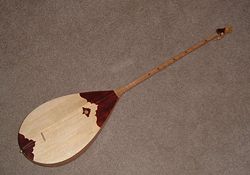- Dombura
-
Dombura 
Classification Related instruments See also Tanbur.The dombura (in Turkish dombıra, in Uzbekistan and Tajikistan, also rendered dambura or danbura in northern Afghanistan, Tajikistan, and Uzbekistan,[1] dumbura in Bashkir and Tatar, dombor in Mongolia, dombyra in Kazakhstan, Dombira or 冬不拉--Dongbula in Xinjiang, China) is a long-necked lute popular in Central Asian nations. The name dombura is the Turkic rendering of Persian tanbur. The instrument shares some of its characteristics with the Central Asian komuz and dutar.
Contents
Varieties
The instrument differs slightly in different regions. The Kazakh dombra has frets and is played by strumming with the hand or plucking each string individually, with an occasional tap on the main surface of the instrument. While the strings are traditionally made of sinew, modern domburas are usually produced using nylon strings.

The Turkestani and Badakhshani damburas are fretless[2] with a body and neck carved from a single block of wood, usually mulberry or apricot. The dambura is played with much banging and scratching on the instrument to help give a percussive sound. The two strings are made of nylon (in modern times) or gut. They cross a short bridge to a pin at the other end of the body. There is a tiny sound hole in the back of the instrument, while the top is thick wood. It is not finished with any varnish, filing/sanding of any kind, and as with all other Afghan instruments there is some decoration.[2]
The Dumbura is the equivalent instrument of the Tatars and Bashkirs. A performer strikes all the strings at the same time. The upper string performs the bourdon tone and the lower string performs the melody. A dumbura is used as a solo as well as an ensemble instrument.
Dombura, ensemble and epic
The Kazakh poet Abay Qunanbayuli is often shown holding a dombra at rest and many hold it in high regard as a symbol of nationalism among the post-Soviet nations of the Commonwealth of Independent States. The dombura is played by Erzhan Alimbetov in the Ulytau band.
From the 12th to the 18th century, the dumbura was used by Bashkir sasans to accompany their poetic legends and kubairs. It is mentioned in the epic poem "Zayatulyak and Hiuhiliu". However, by the beginning of the 20th century, the dumbura was forgotten. The sasans were often the main ideologists of ethnic insurrections. So when the Russian administration put down an uprising, they punished the sasans and destroyed their dumburas.[citation needed] In the second half of the 20th century, several reconstructions were carried out. At present, the revivalist work continues. Among others, performer V. Shugayupov works on the revival of the dumbura. The modern wooden dumbura has a pear-shaped or an oval form.[citation needed]
The dambura is popular particularly among the Hazara people. Safdar Tawakoli and Rajab Ali Haidari are notable Afghan dambura players.
References in popular culture
This instrument has become a part of an Internet phenomenon after a video clip from SuperStar KZ, the Kazakh equivalent of the Idol series, was posted on YouTube. The video includes two contestants singing and a third one singing and playing the dombra, which caused the popularity. The name of the original song is Freestailo by R.Lizer, a Kazakh artist.
Sources
External links
- http://www.bashedu.ru/konkurs/kuzbekova/en_variant/instrument.html
- Dombıra(Turkish)
- http://www.bashedu.ru/konkurs/kuzbekova/en_variant/instrument.html
- [1] Dambura Music sounds
- video clip from SuperStar KZ
See also
- tambura (a type of string instrument)
- domra (a similarly pronounced Russian string instrument)
- kobyz (a bowed instrument, played like a cello)
- baglama
- dutar
- Çiftelia
- Music of Central Asia
- Pandura
Categories:- Necked bowl lutes
- Afghan musical instruments
- Kazakhstani musical instruments
- Uzbekistani musical instruments
- Kyrgyz musical instruments
- Bashkir musical instruments
- Tatar musical instruments
Wikimedia Foundation. 2010.

